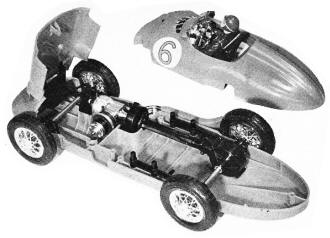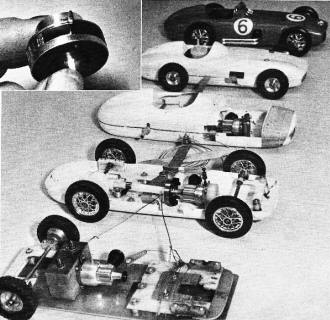|
Now here's a term I had never heard before: "desmodromic valve." I
thought it was something that Cox made up by borrowing the "drom" part of Thimble
Drome. Not so. According to Wikipedia, "In general mechanical terms, the
word desmodromic is used to refer to mechanisms that have different controls for
their actuation in different directions." It describes the type of valve used in
the full-scale Mercedes-Benz
W196 Racer. The Cox model uses their famous .049 glow fuel engine. There is
an ocean of information available on Cox engines, cars, helicopters, boats, and
airplanes. The Cox Mercedes-Benz W196 was a scale model of the real Formula One
car that ran in many European Grand Prix races. The mechanical features were quite
sophisticated, including a flywheel with integrates fan for cooling the engine,
spring-loaded suspension, and an adjustable muffler for desired quietness/power
tradeoff, and careful engineering to assure compatibility of hot metal parts against
molded plastic. The Cox Mercedes-Benz Racer on occasionally shows up on eBay, but
be prepared for a shock price tag compared to the original $20 back in 1961 when
this article appeared in American Modeler magazine ($20 in 1961 =
$206 in 2024 money).
Race Car Clinic: Mercedes Benz G.P.

Not many ready-to-operate models can compare with the L.M. Cox
Mercedes-Benz Racer. Few if any involve the finesse of design and engineering, the
super-realistic features, or the dynamic operation found in this Thimble-Drome .049-powered
car.
Molded largely of tough plastic, including many of the operating parts, this
front-engined, rear-drive machine is the spitting image of its formidable, German-created
big-brother which made its debut at the French Grand Prix in July, 1954. MB's W-196
competed in 13 Grand Prix events in Europe and South America, placing first 10 times.
The big car introduced many sophisticated firsts including desmondromic valving,
full fuel-injection, comfortable independent torsion-bar suspension and four air-cooled
center-mounted brakes. Its eight-cylinder in-line horizontal engine developed 290
hp at 9,500 maximum rpm. The car had five speeds forward, one in reverse. Cox's
faithful copy is a pacesetter, too!
Shining twin chrome exhaust pipes, black screen grille and four scale wheels
with black vinyl tires (tougher than rubber, these insure slippage when starting
to reduce chances of a stalled engine); Mercedes-emblemed racing hubs are among
many eye-catching features.
Axle springs take up shocks of rough running surfaces. An easily attached plastic
bridle is included. The tether is available as a separate item or as part of a kit
which includes battery, fuel, connector. An ingenious hood on the W-196, hinged
at its front end, is released by pulling back on the spring-loaded steering wheel.
This exposes the front-end suspension and the rear half of the engine, including
items which must be accessible-tank, filler tube, needle valve and adjustable muffler.
A plastic, centrifugal blower-metal flywheel adjacent to the engine-shaft back washer
pulls air from around the engine, forcefully exhausting it outside the car. This
prevents overheating or engine burn-outs while needle valve is being adjusted before
a run.
The car body splits into top and bottom shells from the rear hood line back.
Rear wheels and end, drive shaft, and axle springs lift out after the top shell
is removed. The drive-shaft makes a universal joint at both ends, by a U-slot arrangement
at the rear-end gear box and by a two-pin attachment to the flywheel-blower. The
special Cox engine snugly fits its familiar four-hole mount and tank.

Tiny 3-piece muffler's spring band circling two discs opens or
closes to alter exhaust noise. Spring acts as stop as cylinder fires, opens from
pressure of exhaust gases.
Cox copied-in-plastic W-196 race car is unique in its detail
amazingly sturdy. Note evolution of model in the photograph below.
The springing action affords individual four-wheel suspension, important because
the car is able to hug the surface at high speeds instead of bouncing at every rough
spot. The car is not made steerable, the front wheels are set straight ahead to
insure smooth starts and to eliminate spin-ins which could kink a tether line.
The gear unit contains bevel gears in a plastic case, with a 3.07 to 1 ratio,
ideal for rapid acceleration without slowing the engine to the stall point. This
ratio used with an .049 cubic inch displacement engine in a car of this size (13
1/2") and weight, provides all the urge the machine can handle.
A most significant feature is the adjustable muffler which, as Leroy Cox states,
allows "full-throated roar or quiet neighborhood operation." Both model airplanes
and go-carts have had their troubles with spoil-sport neighbors, so here is a very
smart move indeed. A metal-band - of the rotating-valve type for 360-degree porting
- can be set by hand anywhere from near-closed to way-open. The throttle has an
indexing dimple to give accurate adjustment and prevent accidental movement.
Another unique point-one that makes this car possible at $20 - is the Cox application
of metal-to-plastic fits for working parts. The secret is loose fits; tight fits
between these two materials won't work. When you flip the drive wheel for a start
don't be alarmed by an impression of sloppiness - this is from the purposely loose
fits.
Starting technique is straightforward, may be a bit trickier than firing up an
airplane engine with a prop. You work quickly because the engine position can permit
flooding once the needle valve is opened, if you don't get the mill into operation
promptly. Any delays require than the needle valve be shut down. When held nose
up the tank is higher than the engine.
A suitable booster connector such as Thimble-Drome's own glow head clip which
slips on is essential. Do not overtighten the needle valve when shutting it; fuel
should be filtered and kept clean because of the small orifices in the engine-system.
Starting: Having opened the muffler to "full roar," close the needle valve, then
fill the tank. Put a few drops of fuel (prime) into the exhaust opening (at the
muffler), attach the connector, open the valve 3 1/4 turns, and flip one drive-wheel
vigorously in a forward direction. The engine operates like any glow-plugged powerplant.
We found out several useful things. Because the Cox engine will stand a heavy
prime, one may at times impose on his welcome and flood the engine. When this happens,
don't force the drive wheel ... damage to the engine could result. Instead, invert
the car momentarily and the raw fuel will run out the open muffler - be sure the
piston is down to open the exhaust port (wiggle the drive wheel back and forth).
Cranking can be resumed immediately.
When starting, oil on the drive wheel tire may cause your hand to slip; finger
tips can be nicked by the scale Mercedes "knock-off" racing hub. The sharp edges
on the hub of drive wheel you prefer can be filed smooth. Try a few dummy starts
to determine the wheel most convenient, develop a technique for twisting the wheel
in the easiest possible manner. We found the left drive wheel most convenient. Exhaust,
avec oil, comes back on the right side and onto that wheel; also the exhaust pipe
housing hampers ham-handers starting from the right side.
An old model race car man reported that a spinning bike wheel would give fast
starts when the car drive wheel was forced against the tire. This wasn't a good
idea in the case of the MB. An over-enthusiastic and muscle-bound helper spun the
bike wheel much too rapidly and, while the engine did start quickly, the drive wheel
tire showed some flat spots. So we don't recommend that procedure!
Operate on smooth macadam or concrete. Excessive dust and dirt can be harmful
to the precision-made engine. Judging by the rough handling given our MB by the
neighborhood car fans, the plastic is as strong if not stronger than metal. Cox
road tested the car on a 500-mile run during which it achieved a scale speed in
excess of 300 mph. The little MB stirs up a two-cycle storm - unless you set the
muffler to keep peace with the neighbors!
Posted February 3, 2024
|